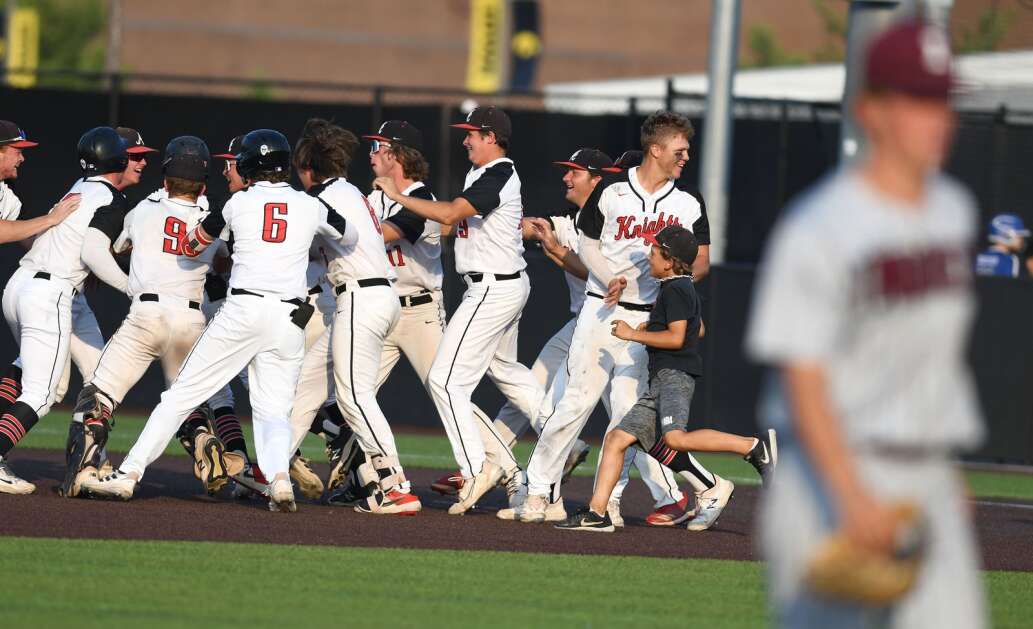An Independence player leaves the field as Davenport Assumption celebrates their victory in the Class 3A Semi-finals of the Iowa High School State Baseball Tournament at Duane Banks Field in Iowa City on Wednesday July 20, 2022. (Cliff Jette/Freelance for the gazette)
The changes in youth sports since the 1970s are as dramatic as the weather in Iowa this summer. Those changes also raise questions about whether the games are modern or should be the main focus.
In the 1970s school sports were the only game in town. There were no tour groups or independent sports schools. To prepare for organized sports, you learned about fetch games on the basketball court or playing on a dusty diamond. He is not a referee or a lawyer in sight. You learned from old friends, patience enough to teach. The rules were flexible and unwritten.
In rural high schools like mine, there were no group tests. Everyone was needed. The only cutting was at home ec. the class was sewing or when there was a big algebra test, we wanted to avoid. I still haven’t solved X. You might not be able to shoot or catch, but you were given a well-used uniform and a spot on the bench.
There were a few great players, but none that made college scouts swoon or have realistic visions of playing basketball or catching fly balls in college. or as a self-employed person.
I don’t remember parents yelling at the coach because their kids are not playing every second. It may have happened, but most parents did not measure their success by how many minutes their sons and daughters played.
Sports were obviously after school, taking second place to academics and farm work. I remember playing baseball and hoping our starting pitcher hadn’t pitched all day before the game. One basketball season, the whole team prayed that our best rebounder would at least get a D- in science so he could play. He didn’t do that.
School teams did not organize sports on Wednesday because it was church night. Again, the practice ended quickly. I’m not sure it was a written rule, but it was respected by even the toughest coach.
It was then. Now.
Private and public schools now have new competition. They now compete for athletes and travel teams that play regionally and sometimes nationally. Those with the money and talent have a choice.
But traveling teams aren’t the only young contenders with the best young talent. TPH sports Academy, a one-stop shop that offers academics and sports for grades 6-12 opened its doors in suburban Des Moines last year.
According to its website, the school currently resides at the Sportsplex West in Waukee but is moving to a state-of-the-art sports complex in Norwalk with “multiple courts, fields, turf setups as well as a training center of operations, 3,000 square feet of classroom space and a restaurant to feed the athletes.”
The daily program states that athletes will have 20+ hours per week of classroom academics and additional online learning. The rest of the day will be used for sports work and student training.
TPH Academy comes with a high tuition fee of $27,999 per year. Parents willing to pay are no doubt dreaming of another Caitlin Clark or George Kittle appearance.
At this Academy, sports are not an afterthought. That idea evolved into the dial-up phone and floppy disk.
It’s all about the games.
Obviously, this is a family choice, but choosing sports as the focus of a young student’s life should raise serious questions. For example, are the parents more concerned about sports or is it the student’s interest?
What if the student does not excel in the chosen sport? What if they are seriously injured?
Sports are a great after-school activity and help many kids stay in school and succeed. But it’s dangerous when it’s original. Sports schools as one place for training and academics is the latest shiny but dangerous trend.
Bruce Lear of Sioux City, taught for 11 years and represented teachers as District Director of the Iowa State Education Association for 27 years until his retirement. BruceLear2419@gmail.com
Opinion content represents the opinion of the writer or The Gazette’s editorial board. You can join the conversation by sending a letter to the editor or guest column or by submitting an article to the editor at editorial@thegazette.com
#Comment #independent #sportsrelated #schools #raise #questions